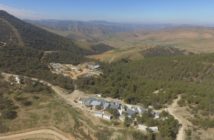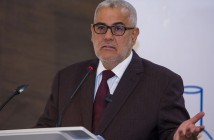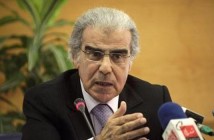 In the heart of Marrakesh, contemporary art gets little peace.
In the heart of Marrakesh, contemporary art gets little peace.
In a former branch of the Banque du Maroc earlier this autumn, sound from a dozen video installations met the cacophony of the historic Djemaa el-Fna square, where food vendors peddled their fare to tourists, snake charmers lined up their cobras and monkeys were paraded on leashes. At dusk, a call to prayer sounded from the Koutoubia Mosque’s landmark minaret.
“It’s a symbolic act to be here,” Hicham Daoudi, founder of the Marrakesh Art Fair, said as he looked out at the teeming agora where 16 people were killed in a terrorist bombing in April.
The exhibition “Images Affranchies,” showing video art and photography from important young Moroccan and Middle Eastern artists, was part of the fair’s desire to reach out to Marrakesh residents who have little experience with contemporary art and may have been put off by a visit to the fair’s white-walled booths at the luxurious Es Saadi Palace, where the well-heeled sipped Champagne and nibbled hors d’oeuvres on a rambunctious opening night.
The fair, whose second edition ran this year from Sept. 30 to Oct. 3, is one of several initiatives that is bringing contemporary art to the nooks and crannies of old-world Marrakesh, through one-off exhibitions, artist residencies, gallery shows or occasional glitzy events, setting worldly expression in what remains an old-world society.
“Marrakesh is burdened by its somewhat folksy postcard image — but we don’t want to be just another city of shishas and Persian carpets,” Mr. Daoudi said. “That culture is no longer relevant to Moroccan youth. We would like people to come to this very touristy city and be able to confront it through contemporary creation.”
Brahim Alaoui, the curator of “Images Affranchies,” chose mysterious, tragicomic and critical works by Mounir Fatmi, Hicham Benohoud and Youssef Nabil. Other work included Mehdi Meddaci’s “Sans titre — Alger la blanche,” dreamy, slow-motion footage of a burqa-clad woman firing a single pistol shot into the air before collapsing, and the Iraqi artist Adel Abidin’s “Memorial,” the heart-wrenching animated death of a cow as it tries to reach its herd across a broken bridge, in a desolate and war-torn landscape. “We wanted to not lock ourselves inside palaces,” Mr. Alaoui said.
During the fair, an accompanying festival at the historic movie theater Le Colisée showed Nabil Ayouch’s controversial film, “Une minute de soleil en moins” (A Minute of Sun Less), which was banned in 2002 for examining homosexuality in Arab society.
“It was a gamble, and I don’t think we could have done it anywhere else in the Arab world,” Mr. Daoudi said. He added: “The fair should not cut itself off from the public, whether people are rich or poor, educated or not.” In one day, about 1,600 people attended the festival’s screenings.
The Marrakesh Art Fair has gained traction since its debut in 2010, almost doubling the number of exhibitors this year — there were 48 galleries from 11 countries, including from Italy, Russia and the United States. Still, Mr. Daoudi said, the fair cannot be fairly judged until its fifth or sixth edition.
The fair and the Marrakesh Biennale, which began in 2005, are bold departures in this city. Most of the galleries still cater to traditional collectors who buy national artists and are easily swayed by the art fancies of King Mohammed VI.
“If Moroccan collectors don’t take an interest in international art, foreign collectors will never pay attention to Moroccan painting,” said Youssef Falaky, a director of the Matisse Art Gallery. “There must be an exchange.”
Matisse is one of the few true galleries in Marrakesh. Painting and photography are most often exhibited in shops or in such locales as the charming Dar Chérifa literary café.
Even if Morocco’s leading gallery circuit remains in Casablanca, Marrakesh is becoming known as a creative hotspot. Recently, new dealers have begun to explore the modern Guéliz neighborhood, among them David Bloch, who opened a street art gallery there last year. There is also Galerie 127, which was North Africa’s first photography gallery when it opened in 2006, and Galerie Rê, which remains one of the city’s sleekest spaces, showing Moroccan and French artists.
“We are trying to fill in for the museums,” said Mr. Falaky, noting that Marrakesh lacks a true modern or contemporary art museum. Matisse divides its exhibitions between younger Moroccan artists, like Badr Bourbian, Hassan Hajjaj and Abderrahim Iqbi, and popular French artists, including Arman, Jacques Villeglé and Pierre Soulages.
The top-down approach is reversed at Dar Al-Ma’mûn, 14 kilometers, about 10 miles, from Marrakesh. Nestled among orchards and small villages, the arts center, named after a ninth-century caliph and scholar, is slowly opening for business in the new Hotel Fellah, an eco-style system of earthy villas and gardens. Through a nonprofit model rare in Morocco, the hotel’s business will finance artist residencies, local education programs and an ambitious library of 100,000 books, with help from Libraries Without Borders.
Construction will begin next year on a new building comprising artist studios, an exhibition space and a reading room that can hold 150 people. The art center is still developing its exhibitions profile, but is pondering a collaboration with the Palais de Tokyo in Paris. Until then, amid scholastic programs for local children, literacy classes for adults and a translation program, the 15 to 20 yearly residencies are a way for Moroccan artists to connect with their international colleagues.
“There is no structure for artists in Morocco, which is a real problem,” said Julien Amicel, the co-director of Dar Al-Ma’mûn, who also helped establish the Point Éphémère art center in Paris. “So they tend to emigrate to England, the United States or France. The country sees limited aesthetic renewal, and there is a rupture in the knowledge of what goes on abroad.”
Dar Al-Ma’mûn is now welcoming its third crop of artists. Recent residents include the Moroccan performance artist Mohamed Arejdal and the French artists Nicolas Moulin and Julia Cottin, who sought inspiration in the architecture of Casablanca’s first high-rise apartment building, Le Liberté. Prominent curators, museum directors and gallery owners have also taken to the project. Marc-Olivier Wahler, the director of the Palais de Tokyo; Enrico Lunghi, the director of the Mudam Luxembourg; and the prominent Paris gallery owner Kamel Mennour have figured on its selection committee. More than 550 artists from 84 countries applied for its latest round of residencies.
“Our only worry is that the high level of the international candidates pushes the Moroccan level comparatively lower,” Mr. Amicel said.
The Moroccan painter Mohamed Mourabiti may be the godfather of the grassroots approach here. In 2000, he set up his studio among the olive trees near Tahanaout, about 30 kilometers from Marrakesh. Since then, he has been painstakingly building Al Maqam, a bright, open artists’ retreat of barn-like work spaces and modern living interiors in buildings made to look like rustic, brown mud houses.
At Al Maqam, time seems to slow down in gardens of lime trees and sculptures. Dozens of artists have transited through the place over the years and left behind mixed-media paintings, sculptures of colorful string, nails and steel wool sponges, and in one room, an Antony Gormley-esque white plaster body cast with barbed wire. One artist, Mahi Binebine, “came for two or three months and has now stayed here for the past five years,” Mr. Mourabiti said.
Humorous and self-deprecating, Mr. Mourabiti began Al Maqam after being told by the École Nationale Supérieure des Beaux-Arts in Casablanca that his grades were not good enough for admittance. “It gave me the idea of a place where your grades are not required,” he said.
Artists learn about the center by word of mouth and are selected through commissions and partner associations.
“There should be more investors in artists, but there unfortunately aren’t in Morocco,” Mr. Mourabiti said. “We have investors who buy walls and hang art to sell it, but we need much more space to create.”
The Marrakesh Biennale increasingly looks like a nexus for the many efforts, drawing world-famous artists for exhibitions, debates and exchanges in the city since 2005. Julian Schnabel, Francis Alÿs, Zadie Smith and Richard E. Grant top the list of invitees for the next edition, from Feb. 29 to March 4, 2012. For the Biennale’s main visual arts show, “Higher Atlas,” 30 artists from 15 countries are perusing Marrakesh, seeking inspiration for works that will be produced specifically for the biennale.
Installations and performances throughout the city should stimulate curiosity and debates around contentious issues, which will be framed by art, cinema and literature.
“We want to leave a legacy of creativity behind, rather than just fly artworks in and leaving them there,” said Vanessa Branson, the director of the Biennale.







